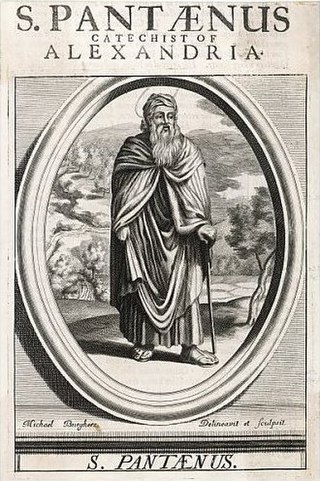Related Research Articles

Babylas was a Syrian patriarch of Antioch (237–253), who died in prison during the Decian persecution. In the Eastern Orthodox Church and Eastern Catholic Churches of the Byzantine rite his feast day is September 4, in the Roman Rite, January 24. He has the distinction of being the first saint recorded as having had his remains moved or "translated" for religious purposes; a practice that was to become extremely common in later centuries.

Pope Peter VII of Alexandria(Abba Boutros El-Gawly), 109th Pope of Alexandria & Patriarch of the See of St. Mark. He was born in the village of El-Gawly in Upper Egypt, and known as Mankarius while a monk at the Monastery of Saint Anthony on the Red Sea.

Synaxarion or Synexarion is the name given in the Eastern Orthodox, Oriental Orthodox and Eastern Catholic Churches to a compilation of hagiographies corresponding roughly to the martyrology of the Roman Church.

Saint Anastasia is a Christian saint and martyr who died at Sirmium in the Roman province of Pannonia Secunda. In the Eastern Orthodox Church, she is venerated as St. Anastasia the Pharmakolytria, i.e. "Deliverer from Potions". This epithet is also translated as "One who Cures (Wounds)" in Lampe's A Patristic Greek Lexicon.

Saint Pantaenus the Philosopher was a Greek theologian and a significant figure in the Catechetical School of Alexandria from around AD 180. This school was the earliest catechetical school, and became influential in the development of Christian theology.

Menas of Egypt, a martyr and wonder-worker, is one of the most well-known Coptic saints in the East and the West, due to the many miracles that are attributed to his intercession and prayers. Menas was a Coptic soldier in the Roman army martyred because he refused to recant his Christian faith. The common date of his commemoration is November 11, which occurs 13 days later on the Julian calendar.
Abba Hor, Besoy, and Daydara were Christian martyrs in Egypt in the fourth century.

Hripsime, also called Rhipsime, Ripsime, Ripsima, Ripsimia, Ripsimus, Arbsima or Arsema was a martyr of Roman origin; she and her companions in martyrdom are venerated as some of the first Christian martyrs of Armenia.

Saint Demiana and the 40 Virgins was a Coptic martyr of the early fourth century.
George El Mozahem was a Coptic Orthodox martyr and saint.
Kyranna of Thessaloniki (1731-1751) is an Orthodox Christian saint and new martyr. Her feast day is on 28 February. She was allegedly killed by an Ottoman official, who unsuccessfully attempted to marry her and force her to convert to Islam.
The Forty-Nine Martyrs of Scetis were Christian monks of the monasteries of Scetis in Roman Egypt who were massacred by Berbers during a raid in 444. Two laymen were martyred along with them. Their relics lie in the Monastery of Saint Macarius the Great. They are venerated in the Coptic Orthodox Church, but not in the Eastern Orthodox or Roman Catholic churches.
Hathor 28 - Coptic Calendar - Hathor 30
Koiak 28 - Coptic Calendar - Koiak 30
Koiak 29 - Coptic Calendar - Tobi 1
Tobi 5 - Coptic Calendar - Tobi 7
Tobi 9 - Coptic Calendar - Tobi 11
Tobi 11 - Coptic Calendar - Tobi 13
Tobi 12 - Coptic Calendar - Tobi 14
Meshir 7 - Coptic Calendar - Meshir 9
References
- ↑ Curtin, D. P. (July 2015). Jacobite Arab Synaxarium- Volume I. ISBN 9781088061237.
- ↑ https://archive.org/details/patrologiaorien01grafplgo
- ↑ http://www.medievalnubia.info/dev/index.php/Synaxarium_Aethiopicum
- 1 2 Holweck, F. G., A Biographical Dictionary of the Saints. St. Louis, MO: B. Herder, 1924